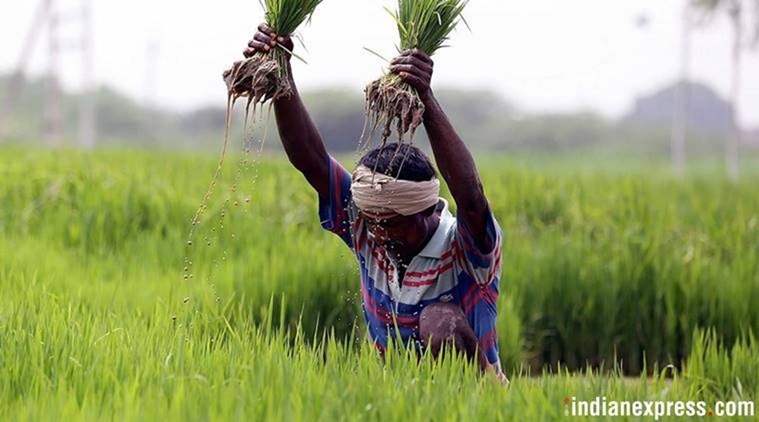 The government has till now received maximum response from Jind, Palwal, Charkhi Dadri, Fatehabad and Sirsa district for the crop diversification. (Representational image)
The government has till now received maximum response from Jind, Palwal, Charkhi Dadri, Fatehabad and Sirsa district for the crop diversification. (Representational image)
After farmers’ anger against restrictions on paddy cultivation and an intense political battle, as many as 38,000 agriculturists have so far agreed to sow alternative crops in place of water-guzzling paddy in little above 1.05 lakh acres in Haryana.
However, the response from farmers has been lukewarm in paddy rich blocks that face major problem of depleting water level.
The Manohar Lal Khattar government in May this year had launched ‘mera pani, meri virasat’ scheme for replacement of paddy by maize, cotton, bajra, pulses in 2.47 lakh acres in targeted blocks which have ground water below 40 metres while offering a financial incentive of Rs 7,000 per acre.
Under the scheme, the farmers were asked to opt crop diversification in at least 50 per cent of their previous year’s cultivated area of paddy in 19 blocks while imposing certain conditions if they did not follow the government order.
However, after agitation by farmers and the opposition, the government had modified the conditions stating that “it was just an appeal to the farmers for crop diversification not a ban on paddy sowing”.
Now, the government is trying its best to convince the farmers to opt the scheme with Chief Minister Manohar Lal Khattar saying, “It’s important to save water for future generations.”
“We have received good response from the farmers to the ‘mera pani, meri virasat’ scheme,” Haryana Agriculture and Farmers Welfare Minister J P Dalal told The Indian Express. “Till the paddy sowing season starts, the registration for the scheme will be on,” added Dalal.
Out of 19 blocks where the ground water level is below 40 metres, the government says, only eight are paddy rich blocks which are; Babain, Guhla, Ismailabad, Pipli, Ratia, Shahbad, Sirsa and Siwan. Despite government’s focus on these blocks for crop diversification, the farmers from these blocks have not shown enthusiasm towards the scheme.
Till now, farmers have got themselves registered for the scheme for crop diversification for only 14,800 acres in these 8 blocks, which includes 9,000 acres of Sirsa block where the farmers have mainly opted cotton in place of paddy.
The government has till now received maximum response from Jind, Palwal, Charkhi Dadri, Fatehabad and Sirsa district for the crop diversification. Explaining the reasons, a senior officer of the agriculture department said, “In the eight paddy rich-blocks where the ground water is below 40 metres, the farmers, except those who have very small land holdings, will get financial incentive from the government only if they diversify at least 50 per cent of the paddy area into alternative crop while there are no such restrictions on the farmers of other blocks.”
So, if a farmer in block Ratia (Fatehabad), which is among eight blocks, opts for crop diversification in two of his total ten acres, then he won’t get financial incentive from the government.
But if a farmer of Charkhi Dadri (south Haryana) wants to replace paddy field with alternative crop in similar area of land, then he will be eligible for the financial incentive.
“This is cruel joke to the farmers of selected eight blocks. Why they should be discriminated. They should also be given financial incentives if they opt for alternative crop in one or two acres of land on the pattern of other districts,” said Mandeep Nathwan, a farmer leader, who had led recent tractor march of farmers against the restrictions on paddy in Fatehabad. “Practically, crop diversification is more difficult for the farmers of paddy rich areas because they have limited options of alternative crops in comparison to other districts because of various factors including geographical conditions,” he added.
Meanwhile, the officials are cautious about the applications submitted by the farmers for crop diversification especially in Palwal district. “We have come to know that the farmers have registered themselves for financial incentive assuring to sow alternative crops in little over than 11,400 acres in place of paddy. But most of these applications have come from those areas which were under the cultivation of cotton. We feel many of them might have applied just in the hope of financial incentive but we will give it to them only after verification at ground,” said an official.
The government has targeted the sowing of paddy crop in about 30 lakh acres this year. The officials hope the farmers will switch to alternative crops in about 1.5 lakh acres finally in place of initial target of 2.47 lakh acres. In fact, according to officials, they were hoping maximum response from the farmers of eight selected paddy rich blocks where 4.4 lakh acre area was under paddy cultivation last year.
But now they have found almost 1.20 lakh acres area flood prone in these blocks where alternative crops are not possible.
The government has suggested the farmers of flood prone areas to opt those varieties of paddy like basmati which requires less water for irrigation to save ground water.